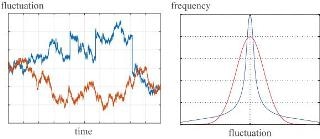Jun 21 2018
Power systems could be severely damaged by sudden variations in the output of wind power generation. A stochastic modeling technique that allows the effect of such phenomena to be evaluated has been developed by scientists from the Kyoto University. The main attribute of the technique is its exceptional computational effectiveness when compared to standard Monte Carlo simulation, as well as its applicability to study and synthesize a range of systems based on extremum outliers.
 (Image credit: Kyoto University)
(Image credit: Kyoto University)
Wind power generation is being actively introduced into the electric power system, mainly in the United States and Europe. Moreover, it is anticipated to continue in Japan. Once implemented, it would be critical to handle uncertainty in the prediction of the output fluctuation. In general, the fluctuation in wind power generation is small; however, it turns extremely large when turbulence and gusts at a non-negligible frequency. These extreme outliers have been considered to be a source of serious damage to power systems.
While coping with such a fluctuation in wind power generation, the goal setting such as “absolutely keep the frequency fluctuation within 0.2 Hz” would be unachievable or would lead to an overly conservative design. Hence, a probabilistic goal setting such as “keep the frequency fluctuation within 0.2 Hz with 99.7% or more” is most essential.
Probabilistic uncertainty is estimated statistically, usually by presuming that it follows normal distribution for its mathematical processability. However, the output outliers in wind power generation are more regular when compared to that represented by normal distribution. Although it is possible to construct a complicated simulator without assuming normal distribution, it would not be realistic to analyze the statistical property by Monte Carlo simulation. This is due to the fact that the needed number of samples increases considerably before adequately more extreme outliers occur.
A technique for evaluating the effect of wind power fluctuation on power system quality was devised. The technique involves first constructing probabilistic models assuming the stable distribution, which is an extension of the normal distribution, on the uncertainty. Next, rather than using the model as a simulator for producing data samples, the statistical properties are computed directly from parameters in the model. Following are the significant attributes: the impact of extreme outliers can be properly taken into account, actual data can be used to easily determine the model can be from, and computation cost is very low. The technique has been proved to be valid upon being applied to frequency deviation evaluation based on actual power system data.
This newly suggested probabilistic evaluation technique allows the power system risk due to the occurrence of extremely sudden variations in wind power generation to be quantitatively evaluated. Corrective steps based on the estimation would help improve the economic efficiency and reliability of the electric power system. Of note is the fact that the suggested technique can be applied for analyzing and synthesizing a range of systems including extreme outliers.